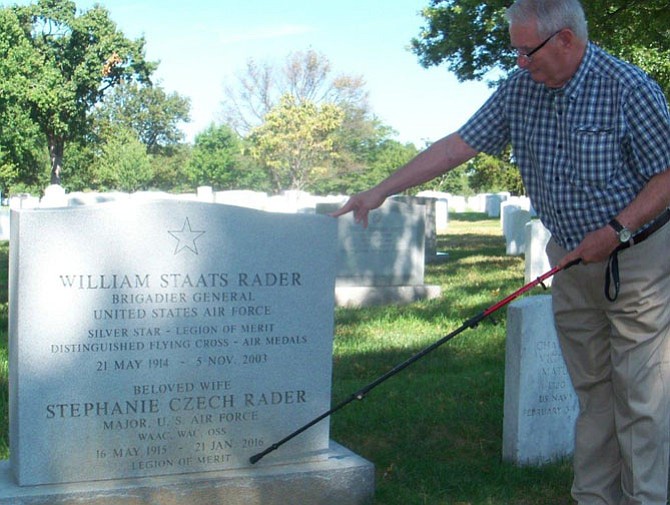Ken Elder, executor of Stephanie Czech Rader’s Estate, inspects her gravestone. Photo by Michael McMorrow.
It is hard to close the book on a hero, and even harder in the case of a celebrated heroine. Stephanie Czech’s story appeared in these pages not long ago (week of June 5). She was in the U.S. Army when detailed to the Office of Strategic Services, predecessor to the Central Intelligence Agency. Raised in an immigrant family, Czech had absorbed Polish language and culture.
The Soviet Union was entrenched in most of Eastern Europe, was sending clear signs that it was not leaving anytime soon and had discarded the smile of recent comradery. The United States needed to know what the Soviets were doing, and Czech had all the tools — and courage — to find out. She assumed the role of embassy clerk, traveled in civilian clothes and lived the cover story of seeking family members who had survived the war. After exploits behind Soviet lines, Czech’s superiors recommended she be decorated for bravery, but nothing resulted. Decades later her personnel records surfaced and she was accorded public recognition, including award of the Legion of Merit posthumously.
Following World War II, Czech wed William S. Rader, himself a highly-decorated pilot who would retire as a flag-officer in the U.S. Air Force. The couple had no children. Her relatives were few in number and distant from the Rader’s Alexandria home.
After Gen. William Rader died, his widow grew close to a select group of neighbors and nearby friends as their mutual lives went on. Among the group were Ken and Judie Elder, who lived across the road. Stephanie Rader chose Ken Elder to be executor of her estate, the one who would close the book for, and on, her. The companion headstone spanning two plots had been installed in Arlington National Cemetery when William Rader died. His name and vital dates and honors were chiseled in, and so were hers with the specifics then known.
During August, Elder was notified the final data for Stephanie Rader had been added to the grave marker. One bright summer day, surrounded by trees and plantings at warm-weather peak and awash with memories of his two deceased friends, Elder confirmed the accuracy of the fresh and final engravings for Stephanie Czech Rader: “21 Jan. 2016” was the death date and “Legion of Merit” was the posthumous honor.
The easy part of Elder’s responsibilities was satisfied. Coming months would consume the details of closing out a person’s life. Finding and settling with creditors, distributing gifts listed in the will, selling the house, disposing of the automobile, paying taxes, accounting for every penny found and spent and filing paper after paper in Alexandria Circuit Court lay ahead. So, too, would the sensitive task of screening personal effects. Questions of family photographs and private correspondence are resolved routinely. Items relating to military service in uniform and undercover require more careful, and caring, scrutiny. Being the case of a widely-celebrated female spy and military veteran, this unusual question also remains for Elder: Should the estate seek to preserve the memory of Stephanie Czech Rader and, if so, what form should that take? Display of items in an OSS Museum or the Women in Military Service for America Memorial has been mentioned. Some have expressed interest in exhibiting the military medals, including the Legion of Merit. As of this writing, Elder has not formulated any answers beyond the single request by Stephanie Rader’s closest relative: The niece asked for the flag which covered her aunt’s coffin during the burial ceremony with full military honors.
